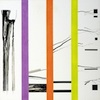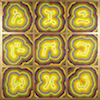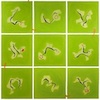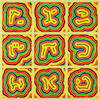|
ON MINIMALISM
By GUSTAV WAGNER Published: Saturday, 6 October 2012 |
|
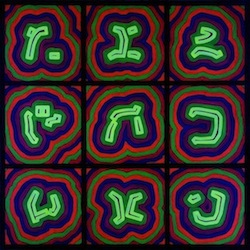 Although clearly avant-garde, Mariscotti's art style does not fall within any recognized art movement. Nevertheless, this does not preclude the interpretation of certain elements in Mariscotti's work from the point of view of various art theories such as Minimalism.
Although clearly avant-garde, Mariscotti's art style does not fall within any recognized art movement. Nevertheless, this does not preclude the interpretation of certain elements in Mariscotti's work from the point of view of various art theories such as Minimalism.
In fact, a cursory examination of one of Mariscotti's latest works immediately reveals certain elements which could be associated with Minimalism. For example, one of the first things that might strike the observer is the fact that the canvas has been divided into nine apparently equal sections. Furthermore, the elements we see in each one of these sections are the same throughout, although not identical in shape. This concept bears great resemblance to Minimalism's "modular repetition", although, there are clear distinctions that can be made.
First, contrary to Minimalism's industrial modularity, Mariscotti takes a more involved approach, for he does not rely on mechanical processes to take over or replace the "responsibility" of the artist. Every section or "module" in the work is carefully rendered by the hand of the artist.
Second, from a distance, the dividing lines drawn on the canvas seem perfectly vertical and straight; however, as we approach the painting, we can discern minute imperfections on the lines. This difference we see between looking at the work from a close distance as opposed to from far away makes reference to the Minimalist idea of intimacy versus detachment. Both effects are included in the work; however, only one is available at a time. The observer cannot get both effects simultaneously.
Third, although quite similar, the modules in Mariscotti's work are not identical. In this sense, Mariscotti diverges from Minimalism since he introduces an element of change, "transformation" to his modules, a notion completely lacking in the Minimalist theory. We can also think of it in this other way: while Minimalist works tend to be static, with no apparent time component attached to them, Mariscotti's works not only incorporate time but make it an integral and essential part of them. Every one of Mariscotti's works takes place "in" time. Furthermore, time implies change, which we can observe in the shape difference of the central figures in each module.
In addition, the "time" element can also be found in the color lines surrounding each main module figure. From a distance those lines appear to be touching one another; however, if we take a closer look, they do not and in fact, they all are the same distance from one another. This observation reveals that this "effect" was most likely produced by design, in an effort to take control over the viewer's visual perception. The line positioning as well as the color choices create a visual effect of movement. This concept of "visual perception" is greatly developed in Minimalist theory; however, it is not being incorporated with the same purpose as in Mariscotti's works.
In conclusion, while Mariscotti's art cannot be placed within any particular category, it is possible to find traces from major movements in the elements found throughout his works.
- G.W.
comments powered by Disqus
| RELATED ARTICLES | |||||||||||
|
|
|
|
||||||||

